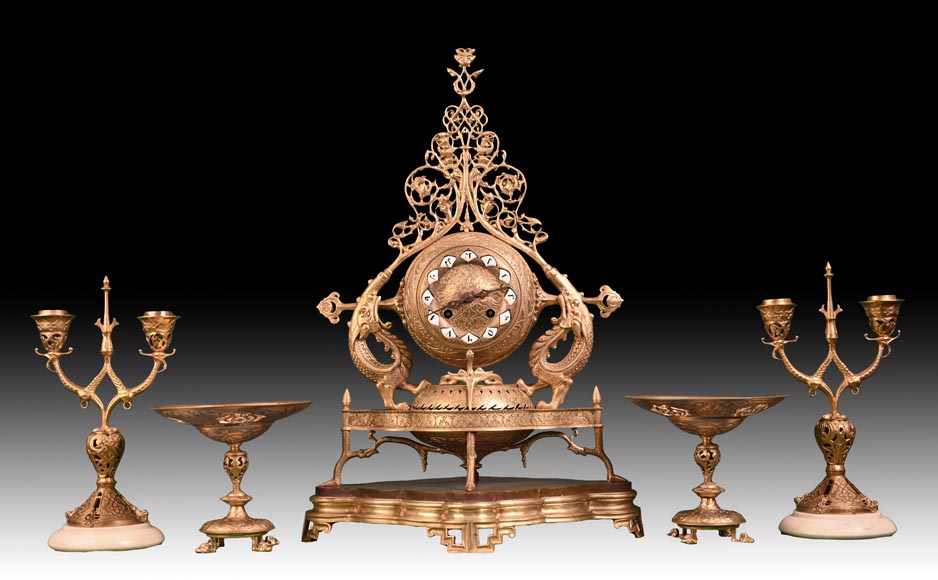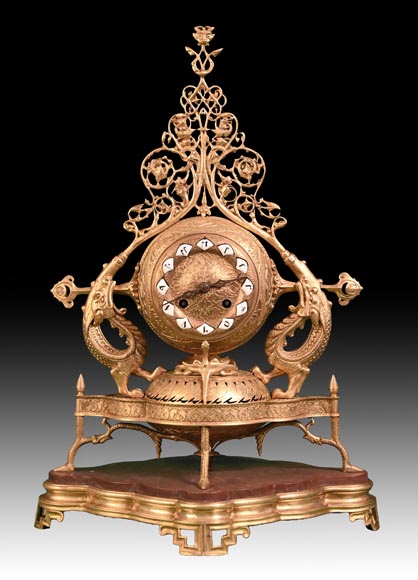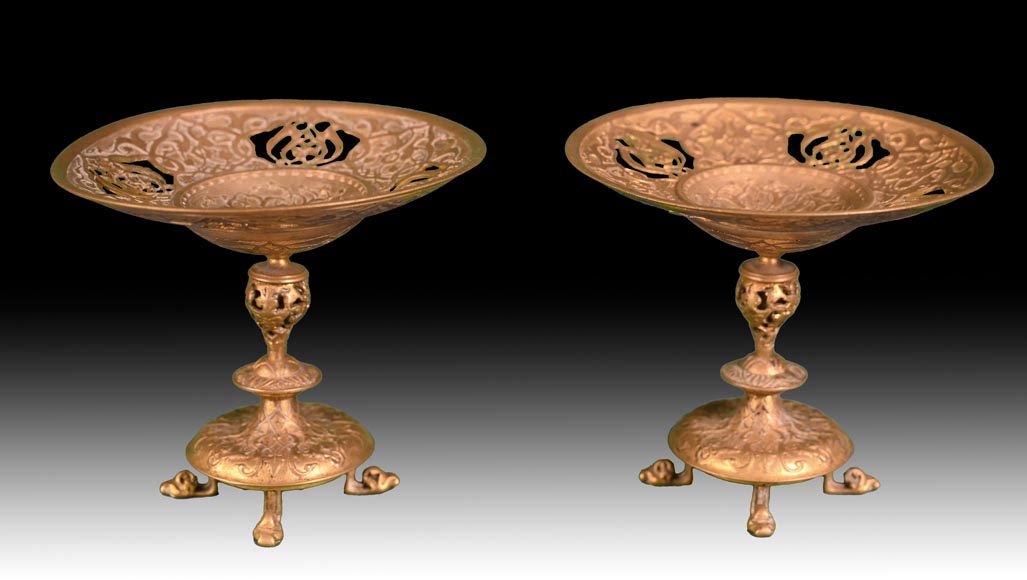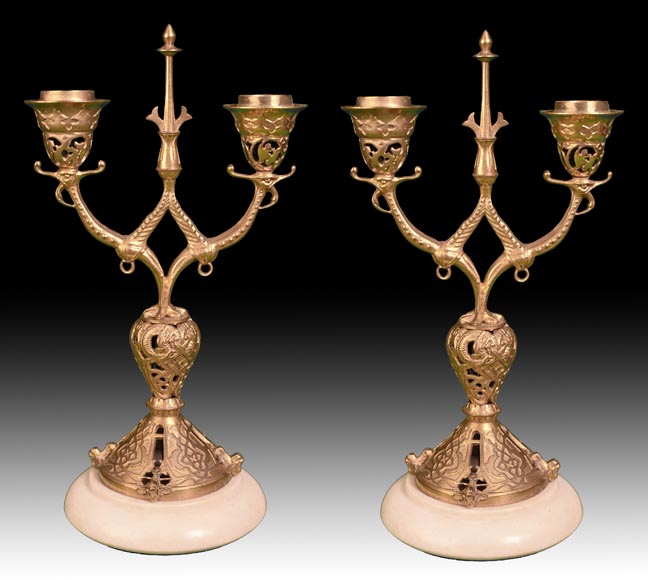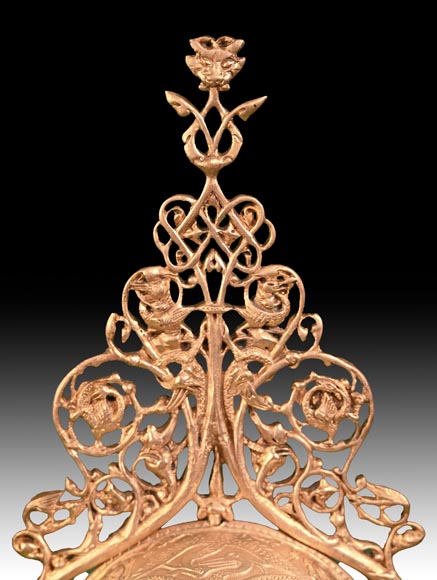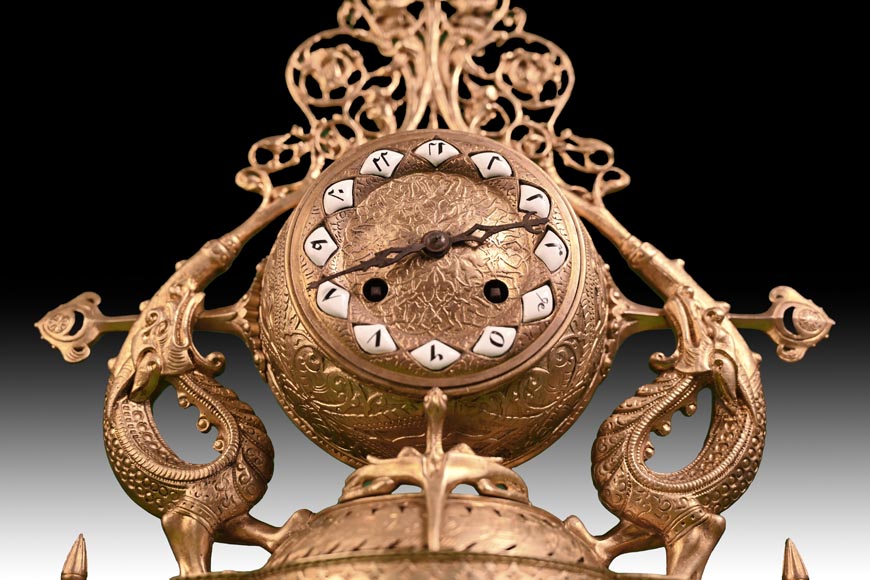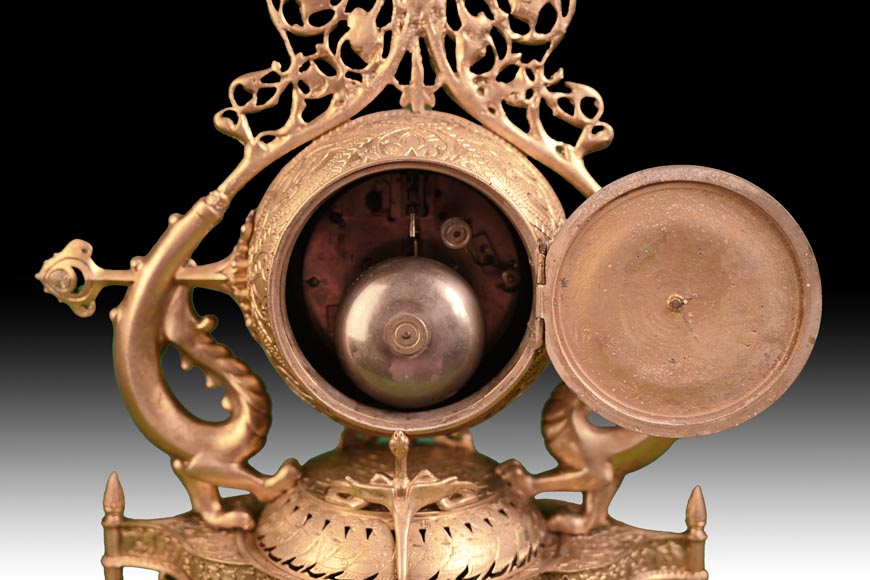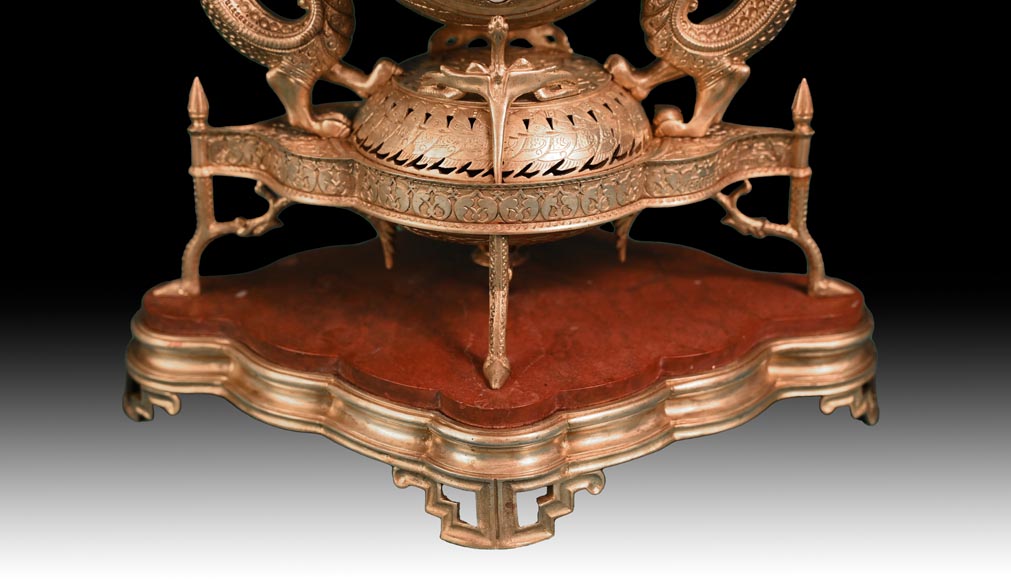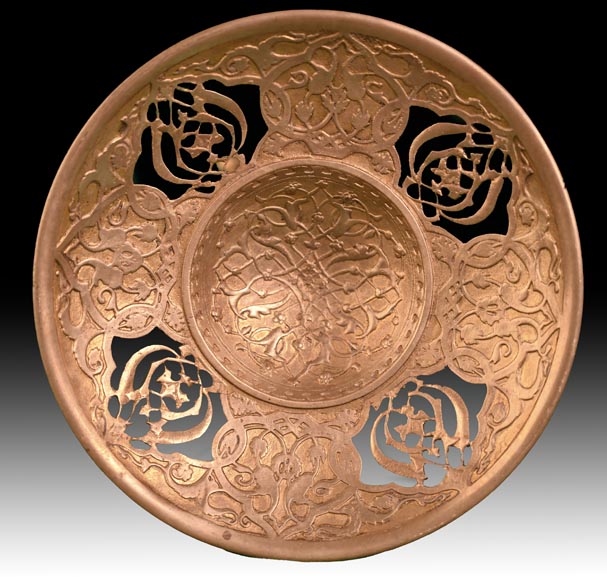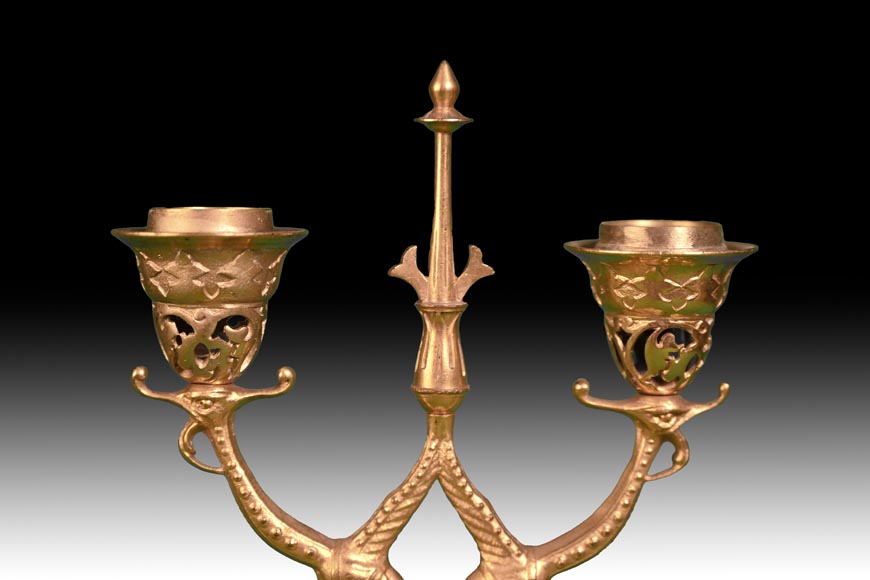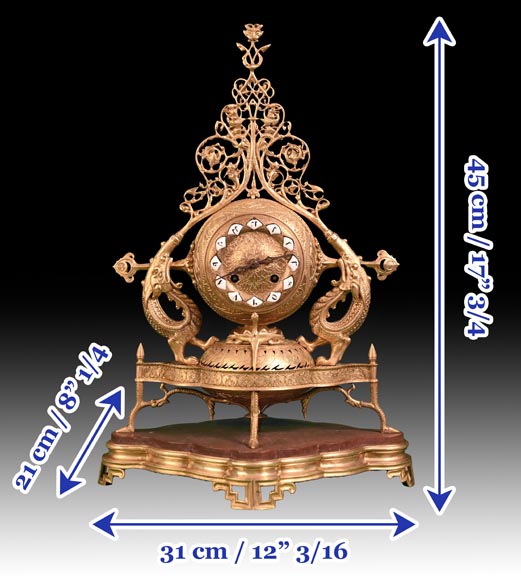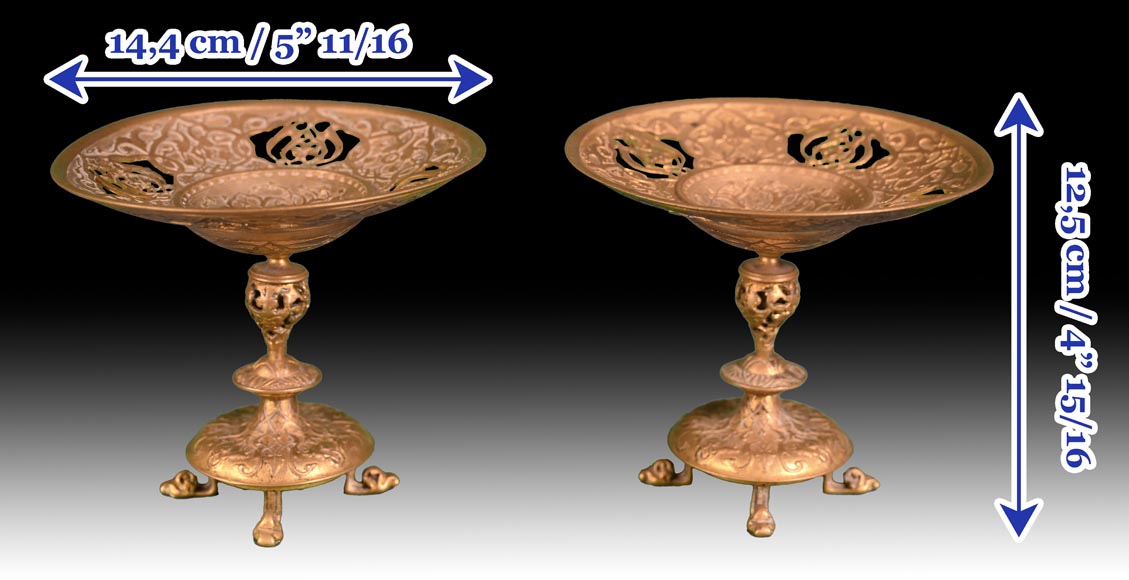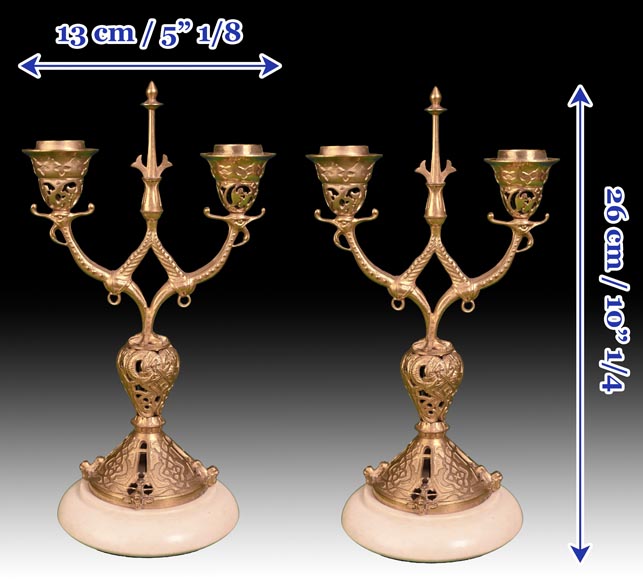Style Orientalism / Ref.15112
Victor GEOFFROY-DECHAUME (model), Auguste-Maximilien DELAFONTAINE (bronze caster), “Persian” Gilt Bronze Clock Set, circa 1852
Dimensions
Width 12'' ¼ 31cm
Height 17'' ¾ 45cm
Depth: 8'' ¼ 21cm
Origin:
France, 19th century
This “Persian” style clock set consists of a clock, a pair of two-light candlesticks, and two tazze in gilt bronze with white marble for the candelabra and red marble for the clock.
The model for this clock set was created by Adolphe Victor Geoffroy-Dechaume, realized by sculptor Charles-François-Édouard Elmerich, and executed by bronze caster Auguste-Maximilien Delafontaine (1813-1892).
The latter, who succeeded his father in 1840, regularly collaborated with Geoffroy-Dechaume from 1847 onwards. Together, they created orientalizing caskets, vases, clocks, and lighting fixtures. Geoffroy-Dechaume’s records reveal that he delivered the design for a “Persian” clock to Delafontaine in 1851-1852. The execution was entrusted to sculptor Elmerich. This design is still preserved in the Geoffroy-Dechaume archives (now in the collection of the Cité de l’Architecture et du Patrimoine in Paris).
The clock’s richly decorated dial features enamel tiles with hours inscribed in Persian numerals. It is flanked by two dragons whose tails extend into multiple scrolls inhabited by fantastic birds. The clock rests on a polylobed base covered with a red marble plaque. It bears the signature of Geoffroy-Dechaume.
The two bowls are elevated by a base with four openwork feet. Their base features multiple interlaced patterns in low-relief, echoing the ornamentation of the clock. In the upper part, the bowls alternate between solid and openwork motifs, giving great delicacy to the ornamentation.
The two candlesticks are finely crafted: on a white marble base, the body of each element is openwork, chiseled, and decorated with scrolls and volutes. The candleholders are supported by two long-necked fantastic animal heads.
An old photograph of the “Persian” clock set by Charles Marville includes the entire garniture: clock, bowls, and candlesticks. Ours has some differences compared to this one: the base of the clock is red marble instead of white, and the base of the two candlesticks is not openwork in our garniture.
It appears that an example of the clock was displayed at the 1855 Universal Exhibition in Paris, on Delafontaine’s stand. He presented numerous candelabra, bowls, caskets, cigar holders and candlesticks designed by Geoffroy-Dechaume, earning a first-class medal on this occasion.
This garniture is a testament to the Persian taste combining references to Islamic and medieval arts, which developed from the late 1840s in all areas of decorative arts, particularly in the work of Victor Geoffroy-Dechaume. This prolific creator of models for civil and religious goldsmithing entered the École des Beaux-Arts in Paris in 1831, where he was a student of David d’Angers and James Pradier. His taste led him to focus on art objects, particularly models for goldsmithing until 1848, when he discovered medieval sculpture. In 1844, he gave the model for the Coupe des Vendanges to goldsmith François-Désiré Froment-Meurice, with the first example preserved at the Louvre Museum. In 1847, he participated in the design of the toilet service made by Froment-Meurice for the Duchess of Parma, now housed at the Musée d’Orsay in Paris.
This Persian garniture, for which he provided the design around 1851-1852, was thus created in line with these major works that marked the first part of his career. He then provided models to many editors and founders of the time, including this garniture, whose model was commissioned by bronze caster Delafontaine.
Around 1850, he turned to the study of monumental statuary, particularly medieval. He became one of Viollet-le-Duc’s main collaborators and participated in the major restoration projects of his time, such as those of Chartres Cathedral, Notre-Dame de Paris, and the Sainte-Chapelle.
A prolific artist, Geoffroy-Dechaume was simultaneously a restorer of religious buildings, a monumental sculptor, an author of commemorative statues, a goldsmith for princes, and a molder. In 1885, he was appointed director of the Musée de Sculpture Comparée (now the Cité de l'Architecture et du Patrimoine).
Informations
Price: on request
Recommended for you :
Dimensions:
Width: 133
Height: 119
Depth: 25
Dimensions:
Width: 32
Height: 46
Depth: 17
Dimensions:
Width: 31
Height: 45
Depth: 21
Dimensions:
Width: 28
Height: 90
Diameter: 21
Dimensions:
Width: 38
Height: 79
Depth: 42
Dimensions:
Width: 47
Height: 84
Depth: 25
Dimensions:
Width: 51
Height: 42
Depth: 20
Dimensions:
Width: 25
Height: 46
Depth: 16
Dimensions:
Width: 41
Height: 38
Depth: 21
Dimensions:
Width: 19
Height: 16
Depth: 10
Dimensions:
Width: 38
Height: 49
Depth: 22
Dimensions:
Width: 34
Height: 67
Depth: 34



